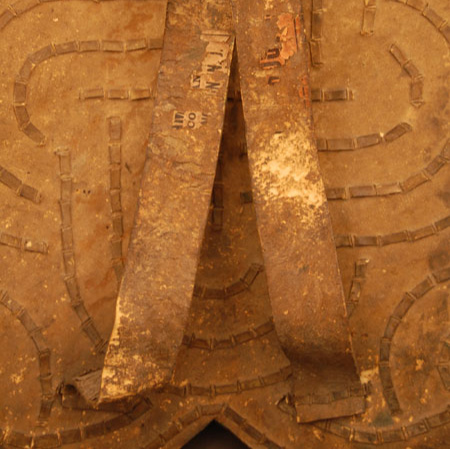The “BAVIA” Adarga – Mexican Leather Shield
The Bavia Adarga (Circa 1836 or earlier)
The Bavia Adarga (Shield) is one of very few Spanish shields extent and perhaps the only one with such clearly demarcated origins. This 18th century heart-shaped shield, or adarga, is composed of two thick layers of rawhide, laced together with narrow thongs. This form of shield (adarga) came with Cortez into Mexico during the early part of the 16th century. It was a form borrowed from the Moors. The name “F. Jones” is inscribed on the back in 19th century manuscript.
The Spanish Presidio of San Antonio Bucareli de la Bavia (Babia) was first established in the valley of Babia in 1772 in the present state of Coahuila as part of a chain of presidios designated as part of the New Regulations. The area known as Coahuila not only encompassed parts of northern Viceregal Mexico but large tracts of land in what presently Texas.
The Presidio de Bavia had the responsibility for protecting and defending the territory south of the Nueces River. Later (1836) the Presidio became one of the bases of operations for the soldiers that fought at the Alamo. A number of the Presidio Soldiers also fought at the Alamo according to early documents.
On the back of the Bavia Adarga is the signature “F. Jones”. After doing some preliminary research the only F. Jones that may have had anything to do with the men at the Alamo was Francis Jones, of Winchester, Tennessee. There is a possibility that this adarga was a war trophy sent back east sometime after the Battle of the Alamo or the Battle of San Jacinto. The following information is a possibility and it will require further research.
Francis Jones was born in Tennessee and his birth date is unknown. Although he received limited schooling: he studied law, and was admitted to the legal bar as an attorney. Jones began his practice in Winchester, Tennessee. During the year 1813, a call was issued for the local militia to be mustered at Winchester. The reason was the terrible Creek Indian massacre at Fort Mims in the Mississippi Territory. David Crockett tells in his autobiography about strong feelings that brought him to volunteer. According to Crockett’s book, a young local lawyer names Francis Jones made a fiery speech, then volunteered and was elected captain, and later represented the district in Congress. Jones was elected Solicitor General of the third Tennessee district in 1815.
Because of Crockett joining up with the militia, this could have had some influence on him deciding to join his comrades at the Alamo. There is a possibility that this adarga was sent back to the east to Francis Jones as a war trophy. Further research may prove this to be true and would be an invaluable asset to an already amazing shield.
Ex.- Pete Kitchen Museum in Southern Arizona
Exhibited: 2010-2012 Many Mexicos: Vistas de la Fronteras; Arizona State Museum, Tucson, Az.
2019-2021 Bullock Museum of Texas History; Austin, Texas










